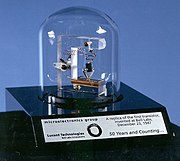History
Main article: History of the transistor
Physicist Julius Edgar Lilienfeld filed the first patent for a transistor in Canada in 1925, describing a device similar to a field-effect transistor or "FET".[1] However, Lilienfeld did not publish any research articles about his devices,[citation needed] nor did his patent cite any examples of devices actually constructed. In 1934, German inventor Oskar Heil patented a similar device.[2]From 1942 Herbert Mataré experimented with so-called duodiodes while working on a detector for a Doppler RADAR system. The duodiodes he built had two separate but very close metal contacts on the semiconductor substrate. He discovered effects that could not be explained by two independently operating diodes and thus formed the basic idea for the later point contact transistor.
In 1947, John Bardeen and Walter Brattain at AT&T's Bell Labs in the United States observed that when electrical contacts were applied to a crystal of germanium, the output power was larger than the input. Solid State Physics Group leader William Shockley saw the potential in this, and over the next few months worked to greatly expand the knowledge of semiconductors. The term transistor was coined by John R. Pierce as a portmanteau of the term "transfer resistor".[3][4] According to physicist/historian Robert Arns, legal papers from the Bell Labs patent show that William Shockley and Gerald Pearson had built operational versions from Lilienfeld's patents, yet they never referenced this work in any of their later research papers or historical articles.[5]

No comments:
Post a Comment